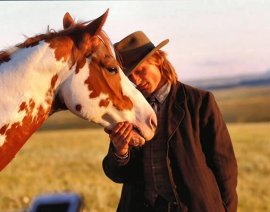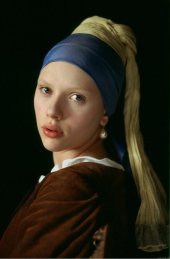 HIDALGO
HIDALGO
As family-friendly adventures go, the Disney-produced western Hidalgo isn't all that bad, but it sure could have used a feistier directorial spirit, something like what Gore Verbinski brought to last summer's Pirates of the Caribbean.
In basic outline, this new film actually recalls Pirates surprisingly often - it features numerous cliffhangher escapes, hissable villains, and a prize that men are wiling to risk their lives for - yet it's too lethargically presented to rival Verbinski's film; it's Pirates on downers, and without Johnny Depp. (Due to the nature of its horse-racing plotline, parallels have inevitably been made with Seabiscuit, but Hidalgo is a slightly more enjoyable work because it's not trying so damned hard to be good for you.) Viggo Mortensen plays Frank T. Hopkins, a real-life American/Native American half-breed, and supposedly the finest rider in the world; the movie's fictionalized take on his tale has him and his titular mustang traveling overseas in the late 1800s to compete in a 3,000-mile race across the Arabian desert. Though the financial rewards of winning the race are more than beguiling, the terrain is so treacherous that many competitors have perished during the trek, and Hopkins faces added pressure from the Arabian rulers - and the reptilian Englishwoman - who would rather see him dead than victorious. How can one lonesome cowpoke and his faithful steed prevail?
Well, casting Viggo in the cowpoke role is a good start. It's been a long while since we've had an American movie star who oozes such simple, charismatic sincerity, let alone one who looks and sounds so natural in period settings. (Kevin Costner should take notes.) With Hidalgo coming on the heels of his performances as Aragorn in the Lord of the Rings films, Viggo riding a horse is like Harrison Ford running or John Cusack emoting in the rain - an iconic screen image that instantly relaxes and satisfies. Yet despite valiant attempts by screenwriter John Fusco to give him a backstory - Hopkins is haunted by the massacre of his Native American tribe, and has to overcome a serious alcohol addiction before heading to Arabia - Mortensen's Hopkins fails to materialize as a character. Hidalgo's director, Joe Johnston, doesn't seem much interested in exploring the drives that would cause Hopkins to participate in the race, but then again, it's difficult to surmise just what Johnston is interested in; every scene in the film exhibits flat, dull competency. Over and over, Johnston leads you to think that something inventive and out-of-the-ordinary will occur and then stops you short. (I could feel the audience instinctively perk up when an enormous swarm of locusts began descending on Viggo and his horse, darkening the Arabian skies - attacks of Biblical proportions are always good for a jolt - but Johnston cuts away from the scene too soon, before we've had a chance to luxuriate in the insects' destructiveness.) Johnston is an acceptable director - his works include Jurassic Park III and October Sky - but not an inspired one. For Hidalgo to succeed, it needed a helmer with some sense of visual style; despite the many beautiful shots of Arabian sunsets and the like, there are no memorable images - it's by-the-numbers filmmaking in a genre that demands a wit behind the camera.
Joe Johnston might not have a great deal of technical prowess, but at least he's pretty adept with actors. In addition to Mortensen, we're treated to the always welcome sight of Omar Sharif, with his sad, kind eyes and curmudgeonly ebullience, J.K. Simmons and Elizabeth Berridge partnering Mortensen in Buffalo Bill's Wild West Show, and, best of all, Louise Lombard as the villainous horse-owner who thinks nothing of having Hopkins offed if it means her horse will finish first; Lombard's every suggestive utterance sounds like a filthy come-on, and as with the locusts, you can feel the audience snapping to attention whenever she shows up. (It's also a refreshing surprise, in a movie with so many Arabic stereotypes, to see an upright British matron cast as the film's uber-villain.) Barring the film's crummy CGI effects - the film's big, "showstopping" sandstorm is mostly embarrassing, and the movie's computer-animated cougar attack is distractingly bad - nothing about Hidalgo is painful to watch; it's a tepid work but relatively pleasant. Yet you leave the film wishing that something in it had truly grabbed your interest; I know the film is set amidst beige-hued deserts and sand dunes and the wild, wild west, but did everything about it have to be so monochromatic?
 GIRL WITH A PEARL EARRING
GIRL WITH A PEARL EARRING
Scarlett Johansson's talents are proving to be almost oxymoronic; she might be the most preternaturally natural talent we've seen in the past decade. What, for me, makes her the most exciting young performer in modern movies is that I can't figure out how, exactly, she achieves her effects. Her low, husky voice barely changes from role to role, and she has a deadpan that could be easily mistaken for affectlessness. (This is occasionally a fine defense mechanism: In movies that don't deserve her, such as Eight Legged Freaks or The Perfect Score, her refusal to emote makes her look blessedly sane.) Yet, within the confines of her under-acting, she's an awfully powerful screen presence. In Lost in Translation, she burrowed so deeply into her character's soulful loneliness that, with only the bare minimum of information given about her, you felt as if you knew Charlotte your whole life, and in Girl with a Pearl Earring, currently playing at the Brew & View, her portrayal of Griet - a maid who was immortalized by Johannes Vermeer in the famed painting of the film's title - is equally astonishing; Griet, in fact, might have half the dialogue of Johansson's Charlotte, yet makes an equally indelible impression. Peter Webber's film, which details the means by which Vermeer (Colin Firth, looking like a sexier Mickey Rourke before he went to seed) gave his young housekeeper immortal life on canvas, is a rich, sharp period piece, dazzlingly detailed and staggeringly well-photographed. Though the intricacies of the plot rely a bit too heavily on the presence of Alakina Mann, that creepy little girl from The Others, as Vermeer's similarly creepy daughter, Girl with a Pearl Earring is a first-rate, subtly moving work. But Johansson makes it nearly unmissable. In a role once earmarked for Kate Hudson(!), Johansson eschews all traces of Hollywood glamour, yet there's nothing about her that isn't radiant. Her fierce intelligence, her staunch refusal of pity, her keen, questioning eyes that take in everything around her - all of the film's drama is located in Scarlett Johansson's face. Her Griet is one of the most realistic pieces of period acting I've seen in years; at age 19, Johansson puts the period performances of actresses such as Winona Ryder and Julia Roberts to shame.










